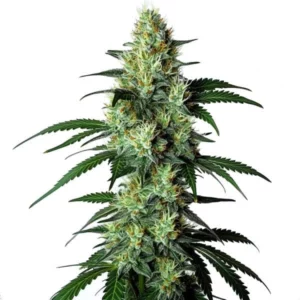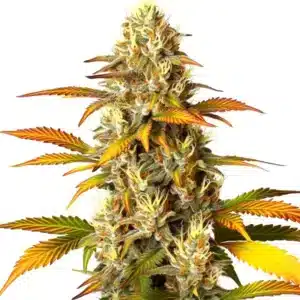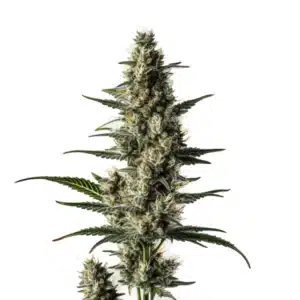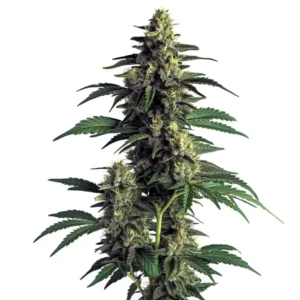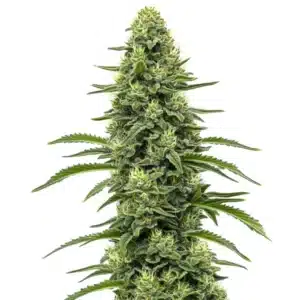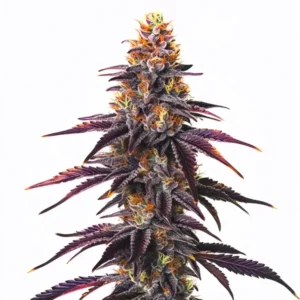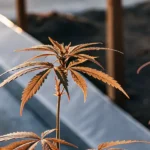
Symptoms of Transpiration Imbalance in Cannabis Plants
Transpiration plays a vital role in the health of cannabis plants. It involves the movement of water through the plant and its eventual evaporation from the leaves. When there’s a transpiration imbalance, you might notice your plants behaving strangely. The symptoms of transpiration imbalance in cannabis plants can vary. To maintain lush, thriving plants, it’s essential to recognize these signs early on.
Leaf curling due to transpiration issues in cannabis is one common symptom. When your plants can’t regulate their water movement effectively, the leaves may curl upwards or downwards. This response is the plant’s way of trying to conserve moisture or protect itself from environmental stress. You’ll often see this in conditions of low humidity or excessive heat.
Recommended Strains
Blue Dream
|
|
THC | 17% - 24% (Medium) |
|
|
Type | Feminized |
|
|
Yield | High |
|
|
Phenotype | 50% Indica / 50% Sativa |
GG4
|
|
THC | 27% (High) |
|
|
Type | Feminized |
|
|
Yield | High |
|
|
Phenotype | 40% Indica / 60% Sativa |
Another symptom to watch for is cannabis plant wilting from transpiration imbalance. Wilting occurs when the plant loses more water than it can replace. This can happen when the air is too dry or when the plant’s roots can’t absorb water quickly enough. Wilting can also be a sign of poor root health, which may be exacerbated by a transpiration imbalance.
Leaf Curling and Wilting
The signs of over-transpiration in marijuana plants are not always obvious. Leaf curling and wilting are two major indicators. When the environment is too hot or dry, the plant’s natural cooling system goes into overdrive. This leads to excessive water loss through the leaves, causing them to curl.
Wilting is another critical sign. If your cannabis plants are wilting, it might mean they’re losing water faster than they can take it up. This is often due to insufficient soil moisture or root problems. Both of these issues can be symptoms of a transpiration imbalance in cannabis plants.
Besides to curling and wilting, other subtle signs can indicate transpiration imbalance. For instance, leaves might develop a papery texture or display discoloration, often appearing dull or slightly gray. These can also be symptoms of transpiration imbalance in cannabis plants, signaling that the plant is under stress.
To address these issues, growers should focus on optimizing environmental conditions. This includes adjusting humidity levels and ensuring adequate soil moisture. Regularly evaluating the growing environment can help prevent leaf curling due to transpiration issues in cannabis, reducing the risk of long-term damage.
Diagnosing Issues with Transpiration
Diagnosing humidity stress in cannabis cultivation requires careful observation. You need to monitor the plant’s environment and its physical condition. If you notice leaf curling and wilting, check the humidity levels. Low humidity can lead to increased transpiration rates, causing these symptoms.
Next, assess the soil moisture. Over-transpiration often coincides with dry soil conditions. Ensure that the soil is moist but not waterlogged. The roots should have access to adequate water without being drowned.
Environmental factors like wind and light intensity can also contribute to transpiration issues. Strong winds can strip moisture from the leaves, while intense light can increase the plant’s internal temperature, exacerbating the symptoms of transpiration imbalance in cannabis plants. Monitoring these factors can be crucial for diagnosing issues effectively.
Moreover, the plant’s genetic makeup might influence its response to transpiration challenges. Some strains are more susceptible to humidity fluctuations. Knowing the specific needs and characteristics of your cannabis strains can aid in diagnosing and addressing humidity stress more effectively.
Promos & Deals
Effects of Poor Transpiration on Cannabis Growth
Poor transpiration affects cannabis growth in several ways. When a plant cannot transpire properly, it struggles to absorb nutrients. This can lead to nutrient deficiencies, impacting overall plant health and slowing growth.
Additionally, transpiration imbalances can affect the plant’s ability to photosynthesize. Without adequate water movement, the plant’s cooling system is compromised. This can lead to heat stress, further inhibiting growth and potentially damaging the plant tissues.
The effects of poor transpiration on cannabis growth extend to the plant’s structural integrity. Stems may become weak and unable to support the weight of the plant, particularly during the flowering stage. This structural weakness can further impair the plant’s ability to grow and produce a healthy yield.
Transpiration imbalance can also affect the plant’s resistance to pests and diseases. With compromised nutrient uptake, plants may become more susceptible to infestations and infections. Ensuring a balanced transpiration process is thus essential for safeguarding against these additional threats.

Choosing the Right Cannabis Strains
Some cannabis strains are more resilient to transpiration imbalances than others. For example, the Blue Dream strain from Blimburn Seeds is known for its robustness and ability to thrive under varying conditions. This makes it a great choice for new growers facing humidity challenges.
The Gorilla Glue 4 strain is another option, offering strong resistance to environmental stressors. Its hearty nature helps it withstand temperature fluctuations and maintain a healthy transpiration rate, reducing the risk of leaf curling and wilting.
In addition to Blue Dream and Gorilla Glue 4, the Northern Lights strain is renowned for its ability to handle environmental stress. Known for its hardy nature, it can adapt to various growing conditions, making it less prone to the symptoms of transpiration imbalance in cannabis plants.
Another strain to consider is the White Widow, which offers good resistance to both heat and humidity fluctuations. This strain’s resilience helps it cope with signs of over-transpiration in marijuana plants, making it a valuable addition to any grower’s collection.
Practical Tips for Managing Transpiration
Managing transpiration involves creating an optimal growing environment. Start by regulating humidity levels. Use a hygrometer to monitor humidity and a humidifier or dehumidifier to adjust as needed. Aim for a relative humidity of 40-60% during the vegetative stage and slightly lower during flowering.
Watering practices also play a crucial role. Make sure the soil remains evenly moist but not saturated. Over-watering can harm roots, exacerbating transpiration issues. Use pots with good drainage to prevent waterlogging and root rot.
It’s also important to consider the type of soil used in cultivation. Well-aerated soil promotes better root health and water uptake, which helps in managing symptoms of transpiration imbalance in cannabis plants. Amending soil with perlite or vermiculite can improve drainage and prevent water stress.
Regular monitoring and adjustments are key to managing transpiration effectively. Utilize technology like environmental controllers to automate humidity and temperature adjustments. This proactive approach can help ensure a stable growing environment for your cannabis plants.
Additional Care Tips
Prune your plants regularly to promote airflow. Removing excess foliage allows for better air circulation, reducing the risk of humidity-related stress. This simple step can greatly help in managing symptoms of transpiration imbalance in cannabis plants.
Consider using fans to enhance air movement. Proper ventilation helps regulate temperature and humidity, supporting healthy transpiration. Position fans to create a gentle breeze that moves across the plants.
Another useful technique is to implement a consistent feeding schedule that addresses potential nutrient deficiencies. Healthy nutrient levels can bolster the plant’s resilience against environmental stressors, reducing the severity of transpiration-related symptoms.
Lastly, rotating your plants regularly ensures even exposure to light and air. This practice helps prevent localized stress and promotes uniform growth, which can mitigate the effects of poor transpiration on cannabis growth.

FAQs on Transpiration Imbalance
What causes leaf curling due to transpiration issues in cannabis?
Leaf curling often results from environmental stress. When temperatures rise or humidity drops, plants lose water rapidly. They respond by curling leaves to reduce surface area and conserve moisture. This symptom is common in hot, dry conditions where transpiration rates are elevated.
Additionally, nutrient deficiencies can contribute to leaf curling. If the plant struggles to absorb nutrients due to poor root health or inadequate soil moisture, it may exhibit curling. Addressing these underlying issues can help resolve the problem.
Leaf curling due to transpiration issues in cannabis can also be exacerbated by pests and diseases. Infestations can interfere with nutrient uptake, further complicating the plant’s ability to manage water loss. Regular inspections can help identify these issues early.
Moreover, genetic factors may play a role. Some strains are naturally more prone to leaf curling under environmental stress. Knowing your plant’s specific genetic traits can aid in tailoring your care approach to minimize symptoms.
How can I identify signs of over-transpiration in marijuana plants?
Signs of over-transpiration include wilting, leaf curling, and dry, brittle foliage. These symptoms indicate that the plant is losing water faster than it can absorb. Observing the plant’s environment can provide clues. High temperatures and low humidity levels often accompany over-transpiration.
Monitoring the plant’s response to environmental changes is key. If symptoms persist despite adjusting conditions, consider checking soil moisture and root health. These factors can exacerbate issues related to transpiration.
Besides to visual symptoms, testing soil moisture levels can provide insights into over-transpiration. Consistently dry soil may indicate that the plant is not receiving enough water, contributing to stress and exacerbating symptoms of transpiration imbalance in cannabis plants.
Using tools such as moisture meters can help in accurately assessing soil conditions. This data can then guide watering practices and other environmental adjustments to mitigate signs of over-transpiration in marijuana plants.
What are the effects of poor transpiration on cannabis growth?
Poor transpiration can lead to nutrient deficiencies, as plants struggle to transport essential elements from the soil. This affects growth and can reduce yield. Additionally, compromised transpiration impairs photosynthesis, impacting energy production and overall plant vitality.
Heat stress is another possible effect. Without adequate transpiration, plants cannot cool themselves effectively. This can damage tissues and slow development. Ensuring a balanced environment helps mitigate these risks.
Additionally, poor transpiration can lead to stunted growth, as the plant’s ability to expand and produce new foliage is hindered. This can be particularly detrimental during the flowering stage, where optimal growth is crucial for a successful harvest.
Another consequence is a weakened immune system, making the plant more susceptible to pests and diseases. By addressing the root causes of transpiration imbalances, growers can support healthier, more resilient plants.
Which cannabis strains are best for managing transpiration imbalance?
Strains like Blue Dream, Gorilla Glue, and Girl Scout Cookies are known for their resilience. Blue Dream is versatile and can adapt to varying humidity levels. Gorilla Glue offers strong resistance to stress factors like temperature fluctuations, making it a reliable choice.
Girl Scout Cookies is another robust option, capable of managing transpiration well. These strains, available at Blimburn Seeds, are excellent for both novice and experienced growers facing transpiration challenges.
Besides to these, the Durban Poison strain is renowned for its adaptability to different environmental conditions. Its robust nature makes it a strong contender for managing symptoms of transpiration imbalance in cannabis plants.
The Sour Diesel strain is also worth considering for its resilience. Known for its ability to withstand various stressors, it is a great choice for growers looking to minimize the risks associated with transpiration imbalances.
How can I prevent cannabis plant wilting from transpiration imbalance?
Preventing wilting involves maintaining proper hydration and environmental conditions. Regularly monitor soil moisture and adjust watering practices to ensure roots have access to water without becoming waterlogged. Use pots with good drainage to avoid root issues.
Regulating humidity and temperature is also crucial. Use a hygrometer to keep track of humidity levels and employ fans for air circulation. These practices help maintain a stable environment, preventing wilting due to transpiration imbalance.
Besides to these measures, incorporating mulching techniques can help retain soil moisture, reducing the likelihood of cannabis plant wilting from transpiration imbalance. Mulch acts as a barrier, slowing evaporation and promoting a more consistent soil moisture level.
Engaging in regular plant maintenance such as pruning and defoliation can also help. By removing excess foliage, you promote better airflow and reduce humidity stress, which is critical for maintaining healthy transpiration rates in cannabis plants.





